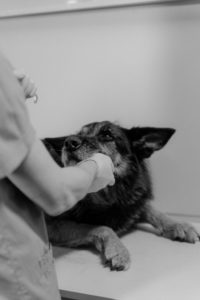
When you first bring a dog or cat into your life, begin making veterinary visits a pleasant experience. Help your pet feel comfortable in his or her crate, carrier or harness, so that car rides are not stressful. Start off slowly, just a ride around the block to acclimate them to the car’s motion. Eventually, take your furry pal to the vet when he or she doesn’t have an appointment, to get on the scale or just sit in the waiting room taking in the sights and smells while enjoying a few treats and ear scratches from you. After a short visit, return home with your best friend NOT having received an injection or procedure. It’s important that animals do not associate pain with their vet’s office, as regular visits are one of the best ways to ensure a long and healthy life by your side.
Sadly, our pets live shorter lives than we do, and for every calendar year that passes, 4 to 7-years of your dog or cat’s life moves forward. That means that if your pet misses an annual exam, that would be like humans not seeing their doctor for 8 to 14 years! A lot can go on in the body in that time, and especially as our pets enter their senior years, twice yearly veterinary visits are important to catch a problem early. Even if you do regular home checks, feeling for lumps and bumps, there is nothing as thorough as a professional Wellness Exam to detect a problem at onset and get your pet the help he needs.
A Mature, Senior, Geriatric or Wellness Exam (different practices use various terminology) should include a complete blood count (CBC) which tells how many red and white cells your dog or cat has. A CBC also shows if there are enough platelets to clot, and alerts your veterinarian to inflammation, anemia or blood diseases that can be detected from just looking at your pet. When blood is drawn for this test, the sample goes into a vial with a lavender top as that denotes a vial containing a chemical that prevents blood from clotting. This allows the lab technician to count individual blood cells. Additionally, a drop of blood is place on a slide to look at the shape and color of your blood cells. Every animal’s blood cells are not identical, and differences can help professionals learn about your dog or cat’s health.
The second part to the blood work in a Senior Wellness exam is blood chemistries. This looks at how well the animal’s organs are functioning, and also if there has been any injury to muscles (yes, that can show up in the blood) or problems with the thyroid. This portion of the blood sample goes into a vial with a red cap. There is no clot preventing chemical in this tube, so the blood can clot allowing the serum (fluid in the blood) to be tested separately for various chemicals and enzymes.
Urinalysis is another component of a wellness check, and helps vets evaluate a pet’s overall kidney function, while parasite exams check for worms, intestinal parasites, and heartworms.
Your veterinarian will also look into your dog or cat’s eyes, mouth and ears, feeling his body for lumps, bumps (like you do weekly), and any abnormalities in the size of organs. It’s possible that x-rays or an MRI might be suggested to take a look deep under your pet’s skin. One of the last facets of the wellness exam should be your interaction with your pet’s veterinarian. You should be asked questions about any changes in your dog or cat’s habits or lifestyle, and if you’ve paid attention, hopefully you’ll provide good feedback. Inquire about your observations, do you think your pet’s hearing or eyesight may not be as good as it once was? Is your pet sleeping more or not enjoying his favorite food or walks? Is he seeming grouchy lately? Don’t brush anything off as just a sign of getting old. If you pet is not acting like himself, something might be hurting, so speak up as your pet’s advocate!
If the veterinarian mentions a condition or treatment that you don’t understand, kindly ask for a more detailed explanation. You are the one who must make medical choices on your dog or cat’s behalf, so you must be in-the-know. If a test or procedure is suggested, stay one step ahead and inquire as to what the options are based on potential results. No person or pet wants to be poked and prodded endlessly, so knowing what testing would lead to can help you determine how far you want to go, for your pet’s sake, with additional procedures. Especially as your pet develops chronic conditions, it is vital that you never allow the treatment to be harsher than the disease itself.
Be your pet’s best friend and health advocate. Schedule and show up for bi-annual exams, get to know your pet from snout-to-tail, listen carefully and ask questions of your dog or cat’s second best friend, his veterinarian, so that together, you can choose the best options for the longest, healthiest, most pain-free life possible.










